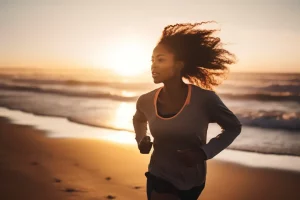Anxiety is a normal and natural response to stress, but it can become overwhelming and debilitating for many people. Along with emotional symptoms, anxiety can manifest as physical symptoms, such as rapid heart rate, shortness of breath, and muscle tension. Fortunately, there are several techniques to help manage these physical symptoms and regain control of your body and mind. In this article, we’ll discuss breathing techniques, mindfulness exercises, and physical activities that can help alleviate the physical symptoms of anxiety.
Breathing Techniques for Anxiety
Breathing techniques are a simple and effective way to deal with anxiety. They help to calm the nervous system, which can reduce the intensity of physical symptoms. Here are three breathing techniques that you can practice whenever you feel anxiety rising:
Diaphragmatic Breathing
Also known as belly breathing, diaphragmatic breathing helps you take deep, slow breaths, which can calm your nervous system and reduce anxiety.
Steps:
- Sit or lie down in a comfortable position.
- Place one hand on your chest and the other on your abdomen.
- Take a slow, deep breath in through your nose, allowing your abdomen to rise.
- Exhale slowly through your mouth, letting your abdomen fall.
- Repeat this process for several minutes, focusing on the rise and fall of your abdomen.
4-6-8 Breathing
This technique involves inhaling for a count of 4, holding the breath for a count of 6, and exhaling for a count of 8. It helps to regulate your breath and slow your heart rate.
Steps:
- Sit or lie down in a comfortable position.
- Close your eyes and take a deep breath in through your nose for a count of 4.
- Hold your breath for a count of 6.
- Exhale slowly through your mouth for a count of 8.
- Repeat this process for at least four cycles.
Box Breathing
Box breathing, also known as square breathing, involves inhaling, holding the breath, exhaling, and holding the breath again for equal counts.
Steps:
- Sit or lie down in a comfortable position.
- Inhale slowly through your nose for a count of 4.
- Hold your breath for a count of 4.
- Exhale slowly through your mouth for a count of 4.
- Hold your breath again for a count of 4.
- Repeat this process for several minutes.
Mindfulness Exercises for Anxiety
Mindfulness is the practice of paying attention to the present moment without judgment. It helps to ground you in the present, preventing the mind from becoming overwhelmed by anxious thoughts. Here are two mindfulness exercises to help manage the physical symptoms of anxiety:
Body Scan Meditation
Body scan meditation involves systematically focusing on each part of your body to become more aware of physical sensations and release tension.
Steps:
- Lie down in a comfortable position.
- Close your eyes and take a few deep breaths.
- Start at the top of your head and slowly scan down through your body, paying attention to any sensations or tension.
- As you scan, release any tension you find by relaxing the muscles or simply acknowledging the sensations without judgment.
- Continue scanning until you reach the tips of your toes.
Mindful Walking
Mindful walking combines physical activity with mindfulness, helping you to become more present and aware of your body.
Steps:
- Find a quiet place to walk, such as a park or a quiet street.
- Begin walking at a slow, comfortable pace.
- Pay attention to the sensations in your feet as they make contact with the ground.
- Gradually expand your awareness to include the movement of your legs, arms, and the sensation of the air on your skin.
- If your mind wanders, gently bring your focus back to the physical sensations of walking.
- Continue walking mindfully for at least 10 minutes, or longer if you prefer.
Physical Activities to Alleviate Anxiety
Engaging in regular physical activity can help reduce anxiety symptoms. Exercise releases endorphins, which are natural mood elevators, and it can also help regulate the stress response. Here are three types of physical activities that can help manage anxiety:
Aerobic Exercise
Aerobic exercises, such as running, swimming, or cycling, can help improve overall mental health and reduce anxiety. Aim for at least 150 minutes of moderate-intensity aerobic exercise or 75 minutes of vigorous-intensity aerobic exercise per week.
Yoga
Yoga is a mind-body practice that combines physical postures, breathing techniques, and meditation. It can help reduce anxiety by improving physical flexibility, strength, and balance, as well as promoting relaxation and mindfulness. Consider attending a yoga class or practicing with online videos at home.
Strength Training
Strength training, such as weightlifting or bodyweight exercises, can help reduce anxiety by improving physical strength and confidence. Aim for at least two sessions of strength training per week, focusing on all major muscle groups.
Additional Tips for Managing Physical Symptoms of Anxiety
While breathing techniques, mindfulness exercises, and physical activities can help alleviate anxiety, it’s important to consider additional strategies for managing the physical symptoms:
Maintain a Healthy Lifestyle
Eating a balanced diet, getting enough sleep, and staying hydrated can contribute to overall well-being and help reduce anxiety symptoms.
Limit Caffeine and Alcohol
Caffeine and alcohol can exacerbate anxiety symptoms. Consider reducing your intake or avoiding these substances altogether if they contribute to your anxiety.
Reach Out for Support
Talking to friends, family members, or a mental health professional can help you process your anxiety and develop coping strategies. Don’t hesitate to seek support if you’re struggling with anxiety.
Conclusion
Physical symptoms of anxiety can be distressing and disruptive, but there are numerous techniques available to help you manage and alleviate these symptoms. By incorporating breathing techniques, mindfulness exercises, and physical activities into your daily routine, you can gain control over your anxiety and improve your overall well-being. Remember to also maintain a healthy lifestyle, limit substances that may contribute to anxiety, and reach out for support when needed.


